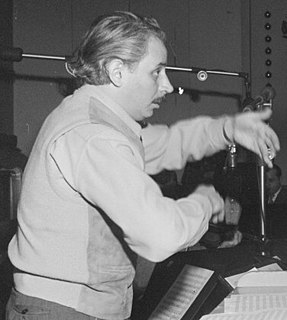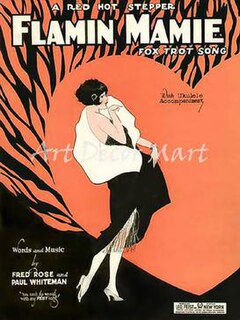
Paul Samuel 'Pops' Whiteman was an American bandleader, composer, orchestral director, and violist.

Gustave "Gussie" Mueller was an early jazz clarinetist.

Mildred Bailey was a Native American jazz singer during the 1930s, known as "The Queen of Swing", "The Rockin' Chair Lady" and "Mrs. Swing". Some of her best-known hits are "For Sentimental Reasons", "It's So Peaceful in the Country", "Doin' The Uptown Lowdown", "Trust in Me", "Where Are You?", "I Let a Song Go Out of My Heart", "Small Fry", "Please Be Kind", "Darn That Dream", "Rockin' Chair", "Blame It on My Last Affair", and "Says My Heart". She had three singles that made number one on the popular charts.

The Casa Loma Orchestra was an American dance band active from 1929 to 1963. Until the rapid multiplication in the number of swing bands from 1935 on, the Casa Loma Orchestra was one of the top North American dance bands. With the decline of the big band business following the end of World War II, it disbanded in 1947. However, from 1957 to 1963, it re-emerged as a recording session band in Hollywood, made up of top-flight studio musicians under the direction of its most notable leader of the past, Glen Gray. The reconstituted band made a limited number appearances live and on television and recorded fifteen LP albums for Capitol Records before Gray died in 1963.

Leonard George Hayton was an American musician, composer, conductor and arranger. Hayton's trademark was a captain's hat, which he always wore at a rakish angle.

"Nobody's Sweetheart", also known as "Nobody's Sweetheart Now" and "You're Nobody's Sweetheart Now", is a popular song, written in 1924, with music by Billy Meyers and Elmer Schoebel, and lyrics by Gus Kahn and Ernie Erdman. The song is a jazz and pop standard.

Van Cleave was a composer and orchestrator for film, television, and radio.
"Lover, Come Back to Me" is a popular song composed by Sigmund Romberg with lyrics by Oscar Hammerstein II for the Broadway show The New Moon, where the song was introduced by Evelyn Herbert and Robert Halliday. The song was published in 1928.
Bob Johnstone was an American traditional pop music singer.

Durelle Alexander was a child performer who appeared in "Hollywood Junior Follies" and several silent "Our Gang" comedies throughout the 1920s. As an adult, she had a singing career with several big bands on radio and on tour.

"Flamin' Mamie" is a 1925 jazz classic composed by Paul Whiteman and Fred Rose.

"Charlestonette" is a 1925 jazz composition by jazz musician and bandleader Paul Whiteman and Fred Rose. The song was released as a 78 single by Paul Whiteman and His Orchestra.

"Whiteman Stomp" is a 1927 jazz composition by musician and bandleader Paul Whiteman, Fats Waller, and Jo Trent. The song was released as a 78 single by both Paul Whiteman and Fletcher Henderson.

"Wang Wang Blues" is a 1920 jazz composition written by Henry Busse, Gussie Mueller, and Theron E. "Buster" Johnson, with lyrics by Leo Wood. The song was released as a 78 single by Paul Whiteman and his Orchestra featuring Henry Busse on trumpet. The song is a pop and jazz standard.
Gordon "Felix" Mills, was a composer, arranger and conductor during the Golden Age of Radio in the 1930s and 1940s. He was the musical director for The Mickey Mouse Theater of the Air, a Disney radio show of the 1930s. Mills created a "gadget band" with wild instruments for Donald Duck to direct on some episodes. He also created arrangements for the show.
Charles Agnew was a popular dance-band leader. Most popular in the 1930s as a midwestern territory band appearing in a sequence of hotel ballrooms, he enjoyed a long career that extended into the 1960s.
"Sweet Sue, Just You" is an American popular song of 1928, composed by Victor Young with lyrics by Will J. Harris. Popular versions in 1928 were by Earl Burtnett and by Ben Pollack.
Gus Levene, born Gershun Levene, was an American arranger, composer, orchestrator and guitarist. In the mid-1940s, he was one of the top network radio arrangers. Levene is best remembered for his work as an arranger for Dean Martin and orchestration for numerous Hollywood film productions, including the 1956 hit film The King and I.

"It Happened in Monterey" or "It Happened in Monterrey" is a 1930 song composed by Mabel Wayne, with lyrics by Billy Rose and performed by Paul Whiteman and his orchestra. It was written for the 1930 musical film, King of Jazz, and was subsequently covered several different times in short succession including by the Regent Club Orchestra, George Olsen and Ruth Etting. It fell out of popularity until Frank Sinatra re-recorded it for both his 1956 Capitol release Songs for Swingin' Lovers! and his 1957 live album Sinatra '57 in Concert.
Frank Theodore Hundertmark, known as Frank Hunter, was an American trombonist, bandleader and music arranger. He is now best known for his 1959 exotica album White Goddess. Early in his career he used the name Frank Huntermark, and on some recordings of Latin American music he was credited as Francisco Cazador.













